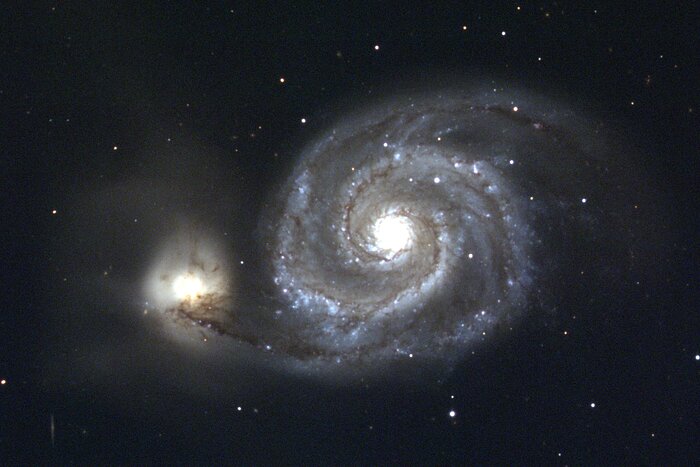M51, the Whirlpool Nebula, NGC 5194/5195.
This image of M51 (NGC5194/5195), was made by combining three CCD frames, taken at the Kitt Peak 0.9m telescope in 1991. By using different filters in front of the monochrome detector, corresponding approximately to the primary colors red, green and blue, it is possible to recreate a true color picture. Each image was processed to correct for detector sensitivity variations and to remove incorrect regions caused by manufacturing defects and by the arrival of cosmic rays at the telescope. Note that this image was reworked in July 2000 to provide a better looking and scientifically more accurate color balance. This picture was made using the `drift scan' technique, in which the telescope is held fixed, not tracking against the Earth's rotation in the usual manner. As the sky passes across the detector, each row of the array is `clocked' along to the next row in step with the apparent motion of the astronomical image. This makes it possible to take a picture of an arbitrarily long strip of the sky, and specialized telescopes exist solely to take advantage of the simplicity of a fixed, non-tracking mounting. The large size of the M51 system, famous as the first clearly recognized spiral nebula, made it necessary to use the drift scan technique. Orientation: N to the left, E down. Note that smaller telescopes with a larger field of view can take such pictures without drift techniques, and can often approach the same quality, especially with clever processing, as this picture from the Kitt Peak Visitor Center's Advanced Observing Program demonstrates. About this object M51 (also known as Arp~85 and VV~1) comprises the large spiral galaxy NGC5194 and its smaller, barred and more amorphous companion NGC5195. Some features are better seen in a color picture: note, for example, how NGC5195 takes on a reddish tinge due to the fact that it is behind the dust-filled arm connecting it to NGC5194. M51 was the first astronomical object in which spiral structure was discerned, by the Third Earl of Rosse in 1845. The spiral arms are perhaps the most perfect `textbook' example in any nearby galaxy, and their very perfection points to the presence of a long-lasting confining mechanism. This may be provided by the tidal pull of NGC5195, whose gravitational effects can generate the necessary spiral density waves. This pattern also shows up in radio emission, suggesting that the magnetic fields in the Whirlpool are also compressed by the density wave. The innermost core of NGC5194 contains a bright ultraviolet source, as well as one of the brightest known compact radio sources. Although smaller and less massive than our own Galaxy, M51 is considerably brighter, due to recent star formation and the resultant dominance by young, hot, bright stars of types O and B. Location: 13 27 50 +47 29 (1950.0), constellation of Canes Venatici. Distance: approximately 31 million light-years. Size: over 65000 light-years across.
Credit:Todd Boroson/NOIRLab/NSF/AURA/
About the Image
| Id: | noao-noao-m51-kpno-09m-2 |
| Type: | Observation |
| Release date: | June 30, 2020, 9:33 p.m. |
| Size: | 2048 x 1366 px |
About the Object
| Name: | M51, NGC 5194, NGC 5195, Whirlpool Galaxy |
| Constellation: | Canes Venatici |
| Category: | Galaxies |
Coordinates
| Position (RA): | 13 29 52.63 |
| Position (Dec): | 47° 12' 37.81" |
| Field of view: | 14.72 x 9.82 arcminutes |
| Orientation: | North is 90.0° left of vertical |
Colors & filters
| Band | Wave-length | Tele-scope |
|---|---|---|
| Optical B | 435 nm | WIYN 0.9-meter Telescope CCD |
| Optical g | 475 nm | WIYN 0.9-meter Telescope CCD |
| Optical r | 635 nm | WIYN 0.9-meter Telescope CCD |

